The Rise of New World Wine Producers
VerifiedAdded on 2021/04/21
|7
|2070
|25
AI Summary
The assignment explores how New World wine producers outshone their Old World counterparts due to their adaptability in production methods, access to resources, and technological capabilities. The shift in consumer demand for high-quality wines also favored New World sources. The resource-based view of strategy is applied to understand the competitive advantage of New World producers.
Contribute Materials
Your contribution can guide someone’s learning journey. Share your
documents today.
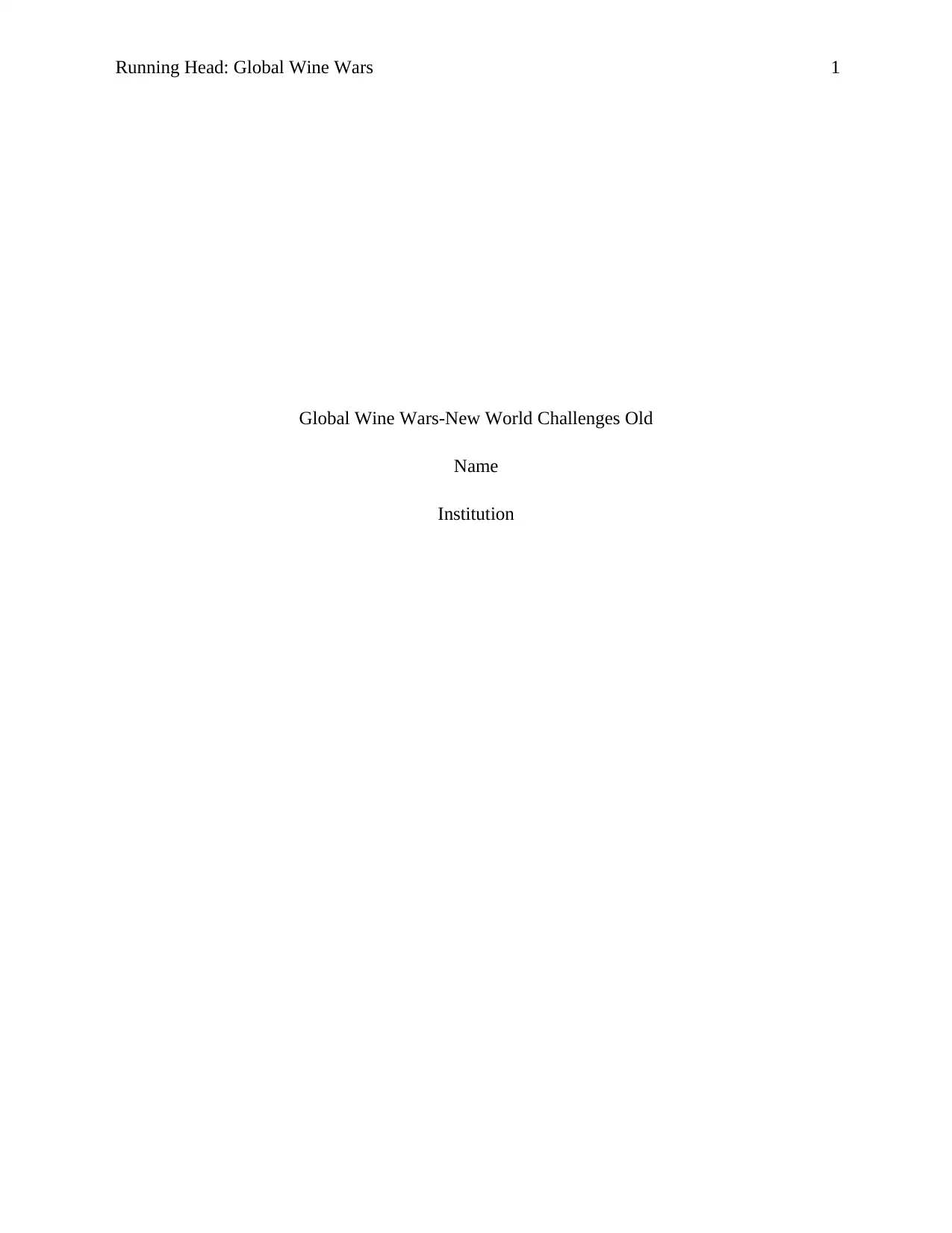
Running Head: Global Wine Wars 1
Global Wine Wars-New World Challenges Old
Name
Institution
Global Wine Wars-New World Challenges Old
Name
Institution
Secure Best Marks with AI Grader
Need help grading? Try our AI Grader for instant feedback on your assignments.
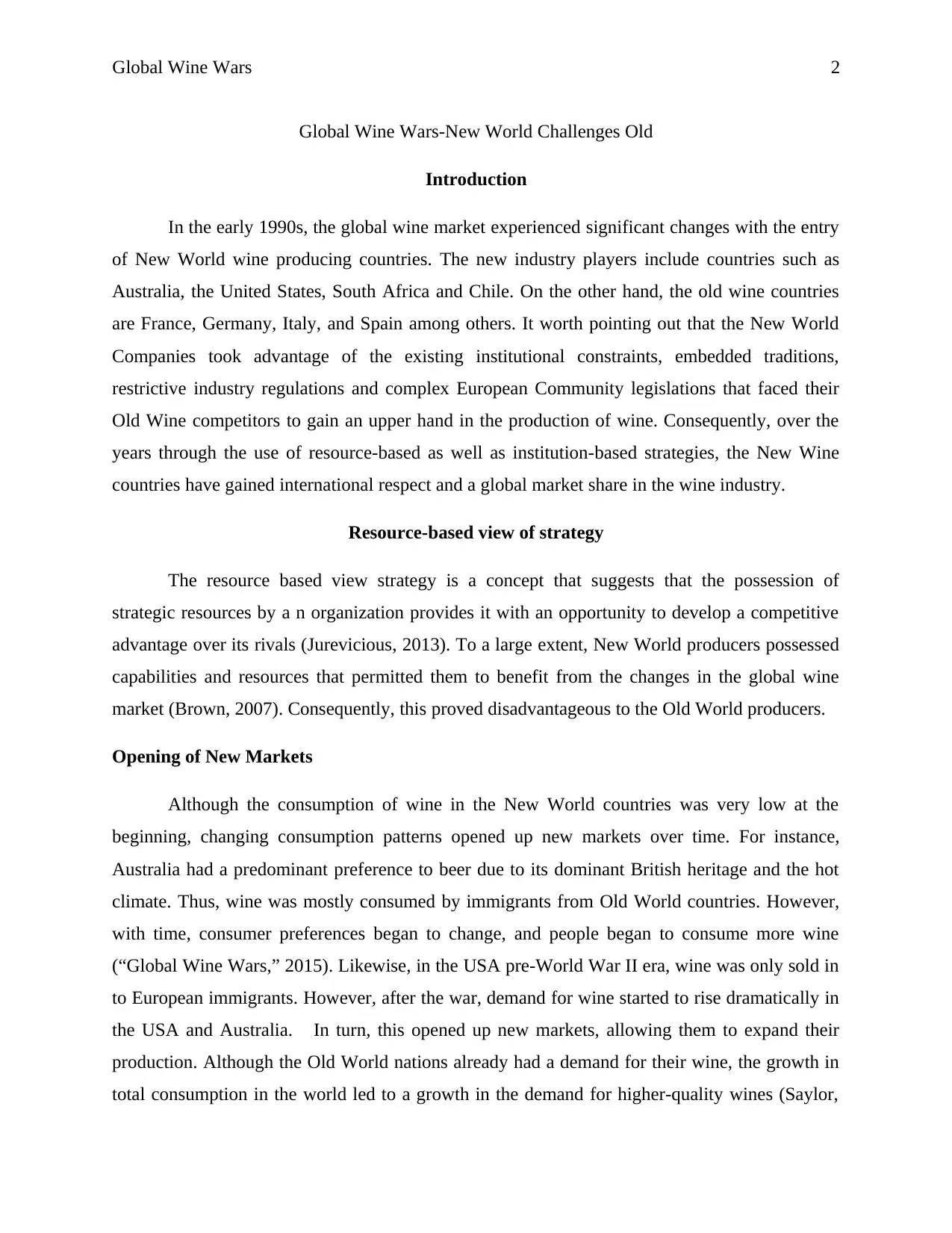
Global Wine Wars 2
Global Wine Wars-New World Challenges Old
Introduction
In the early 1990s, the global wine market experienced significant changes with the entry
of New World wine producing countries. The new industry players include countries such as
Australia, the United States, South Africa and Chile. On the other hand, the old wine countries
are France, Germany, Italy, and Spain among others. It worth pointing out that the New World
Companies took advantage of the existing institutional constraints, embedded traditions,
restrictive industry regulations and complex European Community legislations that faced their
Old Wine competitors to gain an upper hand in the production of wine. Consequently, over the
years through the use of resource-based as well as institution-based strategies, the New Wine
countries have gained international respect and a global market share in the wine industry.
Resource-based view of strategy
The resource based view strategy is a concept that suggests that the possession of
strategic resources by a n organization provides it with an opportunity to develop a competitive
advantage over its rivals (Jurevicious, 2013). To a large extent, New World producers possessed
capabilities and resources that permitted them to benefit from the changes in the global wine
market (Brown, 2007). Consequently, this proved disadvantageous to the Old World producers.
Opening of New Markets
Although the consumption of wine in the New World countries was very low at the
beginning, changing consumption patterns opened up new markets over time. For instance,
Australia had a predominant preference to beer due to its dominant British heritage and the hot
climate. Thus, wine was mostly consumed by immigrants from Old World countries. However,
with time, consumer preferences began to change, and people began to consume more wine
(“Global Wine Wars,” 2015). Likewise, in the USA pre-World War II era, wine was only sold in
to European immigrants. However, after the war, demand for wine started to rise dramatically in
the USA and Australia. In turn, this opened up new markets, allowing them to expand their
production. Although the Old World nations already had a demand for their wine, the growth in
total consumption in the world led to a growth in the demand for higher-quality wines (Saylor,
Global Wine Wars-New World Challenges Old
Introduction
In the early 1990s, the global wine market experienced significant changes with the entry
of New World wine producing countries. The new industry players include countries such as
Australia, the United States, South Africa and Chile. On the other hand, the old wine countries
are France, Germany, Italy, and Spain among others. It worth pointing out that the New World
Companies took advantage of the existing institutional constraints, embedded traditions,
restrictive industry regulations and complex European Community legislations that faced their
Old Wine competitors to gain an upper hand in the production of wine. Consequently, over the
years through the use of resource-based as well as institution-based strategies, the New Wine
countries have gained international respect and a global market share in the wine industry.
Resource-based view of strategy
The resource based view strategy is a concept that suggests that the possession of
strategic resources by a n organization provides it with an opportunity to develop a competitive
advantage over its rivals (Jurevicious, 2013). To a large extent, New World producers possessed
capabilities and resources that permitted them to benefit from the changes in the global wine
market (Brown, 2007). Consequently, this proved disadvantageous to the Old World producers.
Opening of New Markets
Although the consumption of wine in the New World countries was very low at the
beginning, changing consumption patterns opened up new markets over time. For instance,
Australia had a predominant preference to beer due to its dominant British heritage and the hot
climate. Thus, wine was mostly consumed by immigrants from Old World countries. However,
with time, consumer preferences began to change, and people began to consume more wine
(“Global Wine Wars,” 2015). Likewise, in the USA pre-World War II era, wine was only sold in
to European immigrants. However, after the war, demand for wine started to rise dramatically in
the USA and Australia. In turn, this opened up new markets, allowing them to expand their
production. Although the Old World nations already had a demand for their wine, the growth in
total consumption in the world led to a growth in the demand for higher-quality wines (Saylor,
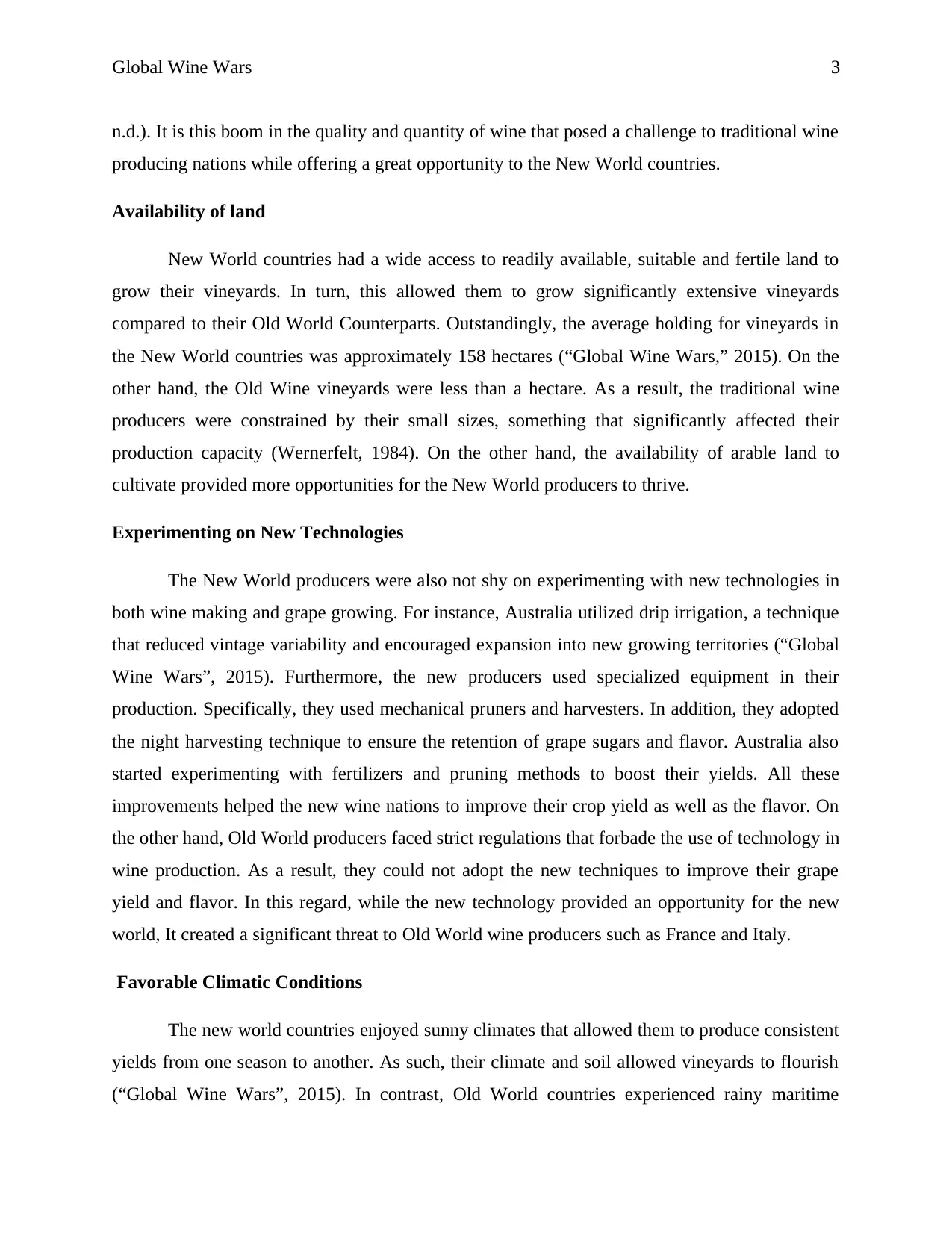
Global Wine Wars 3
n.d.). It is this boom in the quality and quantity of wine that posed a challenge to traditional wine
producing nations while offering a great opportunity to the New World countries.
Availability of land
New World countries had a wide access to readily available, suitable and fertile land to
grow their vineyards. In turn, this allowed them to grow significantly extensive vineyards
compared to their Old World Counterparts. Outstandingly, the average holding for vineyards in
the New World countries was approximately 158 hectares (“Global Wine Wars,” 2015). On the
other hand, the Old Wine vineyards were less than a hectare. As a result, the traditional wine
producers were constrained by their small sizes, something that significantly affected their
production capacity (Wernerfelt, 1984). On the other hand, the availability of arable land to
cultivate provided more opportunities for the New World producers to thrive.
Experimenting on New Technologies
The New World producers were also not shy on experimenting with new technologies in
both wine making and grape growing. For instance, Australia utilized drip irrigation, a technique
that reduced vintage variability and encouraged expansion into new growing territories (“Global
Wine Wars”, 2015). Furthermore, the new producers used specialized equipment in their
production. Specifically, they used mechanical pruners and harvesters. In addition, they adopted
the night harvesting technique to ensure the retention of grape sugars and flavor. Australia also
started experimenting with fertilizers and pruning methods to boost their yields. All these
improvements helped the new wine nations to improve their crop yield as well as the flavor. On
the other hand, Old World producers faced strict regulations that forbade the use of technology in
wine production. As a result, they could not adopt the new techniques to improve their grape
yield and flavor. In this regard, while the new technology provided an opportunity for the new
world, It created a significant threat to Old World wine producers such as France and Italy.
Favorable Climatic Conditions
The new world countries enjoyed sunny climates that allowed them to produce consistent
yields from one season to another. As such, their climate and soil allowed vineyards to flourish
(“Global Wine Wars”, 2015). In contrast, Old World countries experienced rainy maritime
n.d.). It is this boom in the quality and quantity of wine that posed a challenge to traditional wine
producing nations while offering a great opportunity to the New World countries.
Availability of land
New World countries had a wide access to readily available, suitable and fertile land to
grow their vineyards. In turn, this allowed them to grow significantly extensive vineyards
compared to their Old World Counterparts. Outstandingly, the average holding for vineyards in
the New World countries was approximately 158 hectares (“Global Wine Wars,” 2015). On the
other hand, the Old Wine vineyards were less than a hectare. As a result, the traditional wine
producers were constrained by their small sizes, something that significantly affected their
production capacity (Wernerfelt, 1984). On the other hand, the availability of arable land to
cultivate provided more opportunities for the New World producers to thrive.
Experimenting on New Technologies
The New World producers were also not shy on experimenting with new technologies in
both wine making and grape growing. For instance, Australia utilized drip irrigation, a technique
that reduced vintage variability and encouraged expansion into new growing territories (“Global
Wine Wars”, 2015). Furthermore, the new producers used specialized equipment in their
production. Specifically, they used mechanical pruners and harvesters. In addition, they adopted
the night harvesting technique to ensure the retention of grape sugars and flavor. Australia also
started experimenting with fertilizers and pruning methods to boost their yields. All these
improvements helped the new wine nations to improve their crop yield as well as the flavor. On
the other hand, Old World producers faced strict regulations that forbade the use of technology in
wine production. As a result, they could not adopt the new techniques to improve their grape
yield and flavor. In this regard, while the new technology provided an opportunity for the new
world, It created a significant threat to Old World wine producers such as France and Italy.
Favorable Climatic Conditions
The new world countries enjoyed sunny climates that allowed them to produce consistent
yields from one season to another. As such, their climate and soil allowed vineyards to flourish
(“Global Wine Wars”, 2015). In contrast, Old World countries experienced rainy maritime
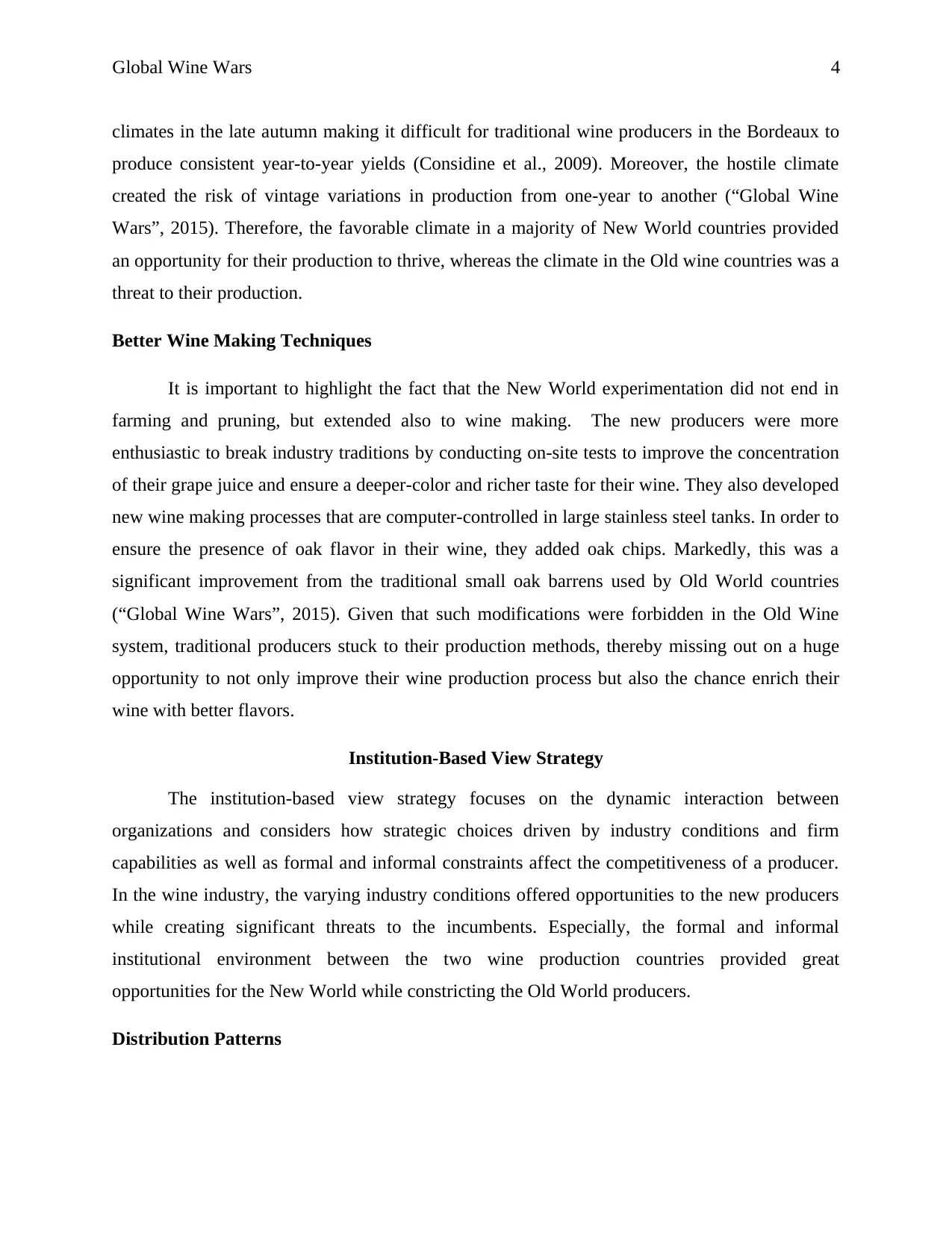
Global Wine Wars 4
climates in the late autumn making it difficult for traditional wine producers in the Bordeaux to
produce consistent year-to-year yields (Considine et al., 2009). Moreover, the hostile climate
created the risk of vintage variations in production from one-year to another (“Global Wine
Wars”, 2015). Therefore, the favorable climate in a majority of New World countries provided
an opportunity for their production to thrive, whereas the climate in the Old wine countries was a
threat to their production.
Better Wine Making Techniques
It is important to highlight the fact that the New World experimentation did not end in
farming and pruning, but extended also to wine making. The new producers were more
enthusiastic to break industry traditions by conducting on-site tests to improve the concentration
of their grape juice and ensure a deeper-color and richer taste for their wine. They also developed
new wine making processes that are computer-controlled in large stainless steel tanks. In order to
ensure the presence of oak flavor in their wine, they added oak chips. Markedly, this was a
significant improvement from the traditional small oak barrens used by Old World countries
(“Global Wine Wars”, 2015). Given that such modifications were forbidden in the Old Wine
system, traditional producers stuck to their production methods, thereby missing out on a huge
opportunity to not only improve their wine production process but also the chance enrich their
wine with better flavors.
Institution-Based View Strategy
The institution-based view strategy focuses on the dynamic interaction between
organizations and considers how strategic choices driven by industry conditions and firm
capabilities as well as formal and informal constraints affect the competitiveness of a producer.
In the wine industry, the varying industry conditions offered opportunities to the new producers
while creating significant threats to the incumbents. Especially, the formal and informal
institutional environment between the two wine production countries provided great
opportunities for the New World while constricting the Old World producers.
Distribution Patterns
climates in the late autumn making it difficult for traditional wine producers in the Bordeaux to
produce consistent year-to-year yields (Considine et al., 2009). Moreover, the hostile climate
created the risk of vintage variations in production from one-year to another (“Global Wine
Wars”, 2015). Therefore, the favorable climate in a majority of New World countries provided
an opportunity for their production to thrive, whereas the climate in the Old wine countries was a
threat to their production.
Better Wine Making Techniques
It is important to highlight the fact that the New World experimentation did not end in
farming and pruning, but extended also to wine making. The new producers were more
enthusiastic to break industry traditions by conducting on-site tests to improve the concentration
of their grape juice and ensure a deeper-color and richer taste for their wine. They also developed
new wine making processes that are computer-controlled in large stainless steel tanks. In order to
ensure the presence of oak flavor in their wine, they added oak chips. Markedly, this was a
significant improvement from the traditional small oak barrens used by Old World countries
(“Global Wine Wars”, 2015). Given that such modifications were forbidden in the Old Wine
system, traditional producers stuck to their production methods, thereby missing out on a huge
opportunity to not only improve their wine production process but also the chance enrich their
wine with better flavors.
Institution-Based View Strategy
The institution-based view strategy focuses on the dynamic interaction between
organizations and considers how strategic choices driven by industry conditions and firm
capabilities as well as formal and informal constraints affect the competitiveness of a producer.
In the wine industry, the varying industry conditions offered opportunities to the new producers
while creating significant threats to the incumbents. Especially, the formal and informal
institutional environment between the two wine production countries provided great
opportunities for the New World while constricting the Old World producers.
Distribution Patterns
Secure Best Marks with AI Grader
Need help grading? Try our AI Grader for instant feedback on your assignments.
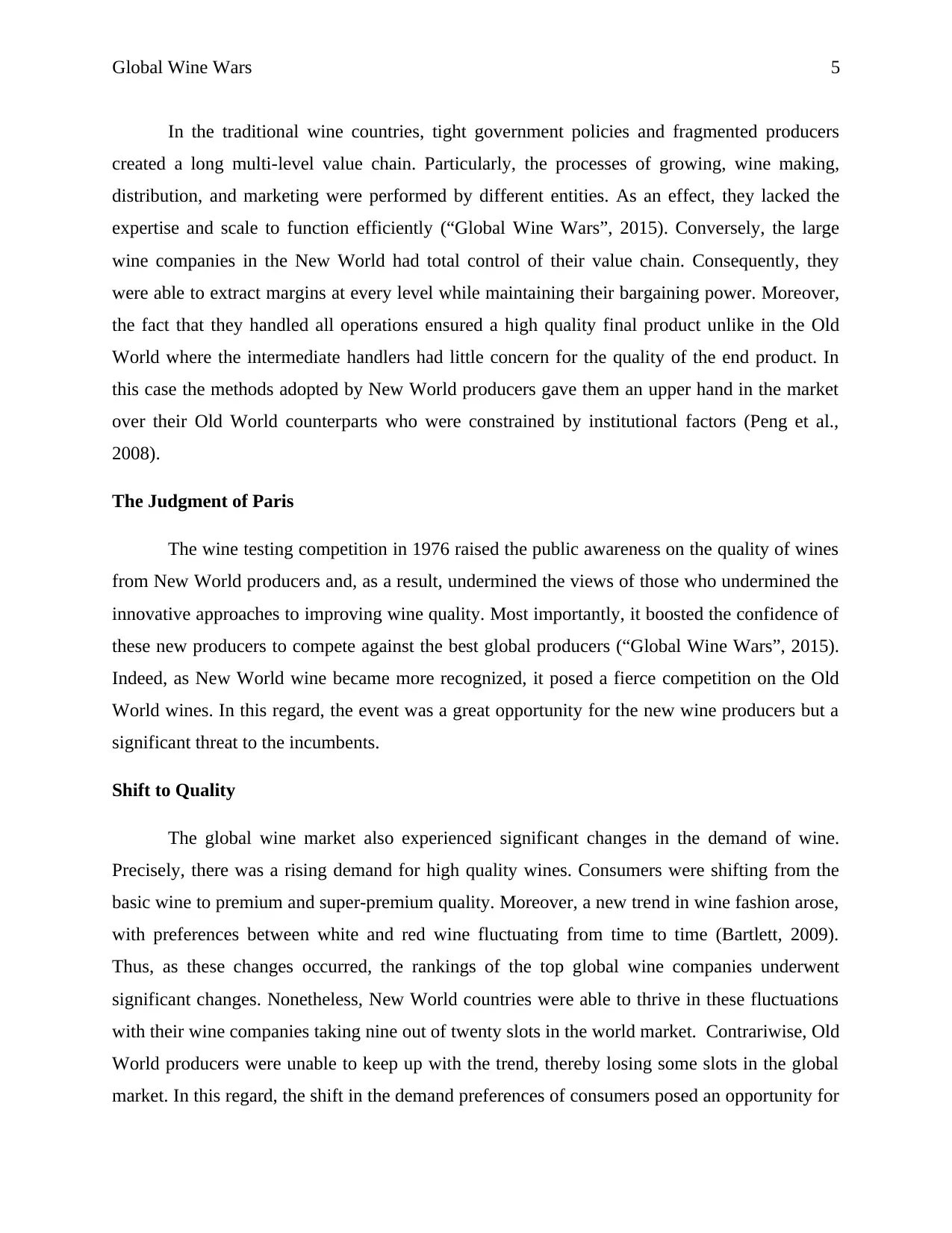
Global Wine Wars 5
In the traditional wine countries, tight government policies and fragmented producers
created a long multi-level value chain. Particularly, the processes of growing, wine making,
distribution, and marketing were performed by different entities. As an effect, they lacked the
expertise and scale to function efficiently (“Global Wine Wars”, 2015). Conversely, the large
wine companies in the New World had total control of their value chain. Consequently, they
were able to extract margins at every level while maintaining their bargaining power. Moreover,
the fact that they handled all operations ensured a high quality final product unlike in the Old
World where the intermediate handlers had little concern for the quality of the end product. In
this case the methods adopted by New World producers gave them an upper hand in the market
over their Old World counterparts who were constrained by institutional factors (Peng et al.,
2008).
The Judgment of Paris
The wine testing competition in 1976 raised the public awareness on the quality of wines
from New World producers and, as a result, undermined the views of those who undermined the
innovative approaches to improving wine quality. Most importantly, it boosted the confidence of
these new producers to compete against the best global producers (“Global Wine Wars”, 2015).
Indeed, as New World wine became more recognized, it posed a fierce competition on the Old
World wines. In this regard, the event was a great opportunity for the new wine producers but a
significant threat to the incumbents.
Shift to Quality
The global wine market also experienced significant changes in the demand of wine.
Precisely, there was a rising demand for high quality wines. Consumers were shifting from the
basic wine to premium and super-premium quality. Moreover, a new trend in wine fashion arose,
with preferences between white and red wine fluctuating from time to time (Bartlett, 2009).
Thus, as these changes occurred, the rankings of the top global wine companies underwent
significant changes. Nonetheless, New World countries were able to thrive in these fluctuations
with their wine companies taking nine out of twenty slots in the world market. Contrariwise, Old
World producers were unable to keep up with the trend, thereby losing some slots in the global
market. In this regard, the shift in the demand preferences of consumers posed an opportunity for
In the traditional wine countries, tight government policies and fragmented producers
created a long multi-level value chain. Particularly, the processes of growing, wine making,
distribution, and marketing were performed by different entities. As an effect, they lacked the
expertise and scale to function efficiently (“Global Wine Wars”, 2015). Conversely, the large
wine companies in the New World had total control of their value chain. Consequently, they
were able to extract margins at every level while maintaining their bargaining power. Moreover,
the fact that they handled all operations ensured a high quality final product unlike in the Old
World where the intermediate handlers had little concern for the quality of the end product. In
this case the methods adopted by New World producers gave them an upper hand in the market
over their Old World counterparts who were constrained by institutional factors (Peng et al.,
2008).
The Judgment of Paris
The wine testing competition in 1976 raised the public awareness on the quality of wines
from New World producers and, as a result, undermined the views of those who undermined the
innovative approaches to improving wine quality. Most importantly, it boosted the confidence of
these new producers to compete against the best global producers (“Global Wine Wars”, 2015).
Indeed, as New World wine became more recognized, it posed a fierce competition on the Old
World wines. In this regard, the event was a great opportunity for the new wine producers but a
significant threat to the incumbents.
Shift to Quality
The global wine market also experienced significant changes in the demand of wine.
Precisely, there was a rising demand for high quality wines. Consumers were shifting from the
basic wine to premium and super-premium quality. Moreover, a new trend in wine fashion arose,
with preferences between white and red wine fluctuating from time to time (Bartlett, 2009).
Thus, as these changes occurred, the rankings of the top global wine companies underwent
significant changes. Nonetheless, New World countries were able to thrive in these fluctuations
with their wine companies taking nine out of twenty slots in the world market. Contrariwise, Old
World producers were unable to keep up with the trend, thereby losing some slots in the global
market. In this regard, the shift in the demand preferences of consumers posed an opportunity for
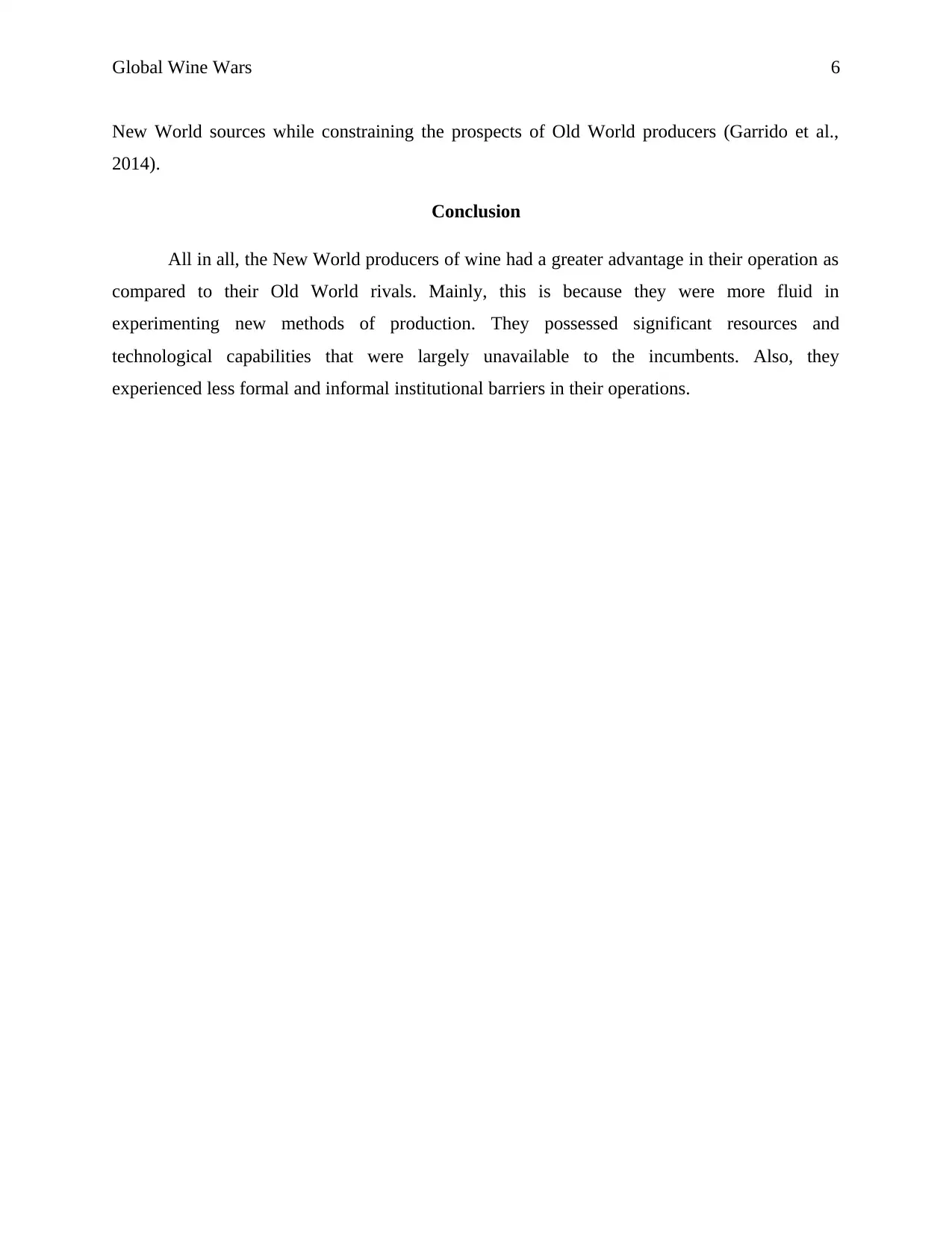
Global Wine Wars 6
New World sources while constraining the prospects of Old World producers (Garrido et al.,
2014).
Conclusion
All in all, the New World producers of wine had a greater advantage in their operation as
compared to their Old World rivals. Mainly, this is because they were more fluid in
experimenting new methods of production. They possessed significant resources and
technological capabilities that were largely unavailable to the incumbents. Also, they
experienced less formal and informal institutional barriers in their operations.
New World sources while constraining the prospects of Old World producers (Garrido et al.,
2014).
Conclusion
All in all, the New World producers of wine had a greater advantage in their operation as
compared to their Old World rivals. Mainly, this is because they were more fluid in
experimenting new methods of production. They possessed significant resources and
technological capabilities that were largely unavailable to the incumbents. Also, they
experienced less formal and informal institutional barriers in their operations.
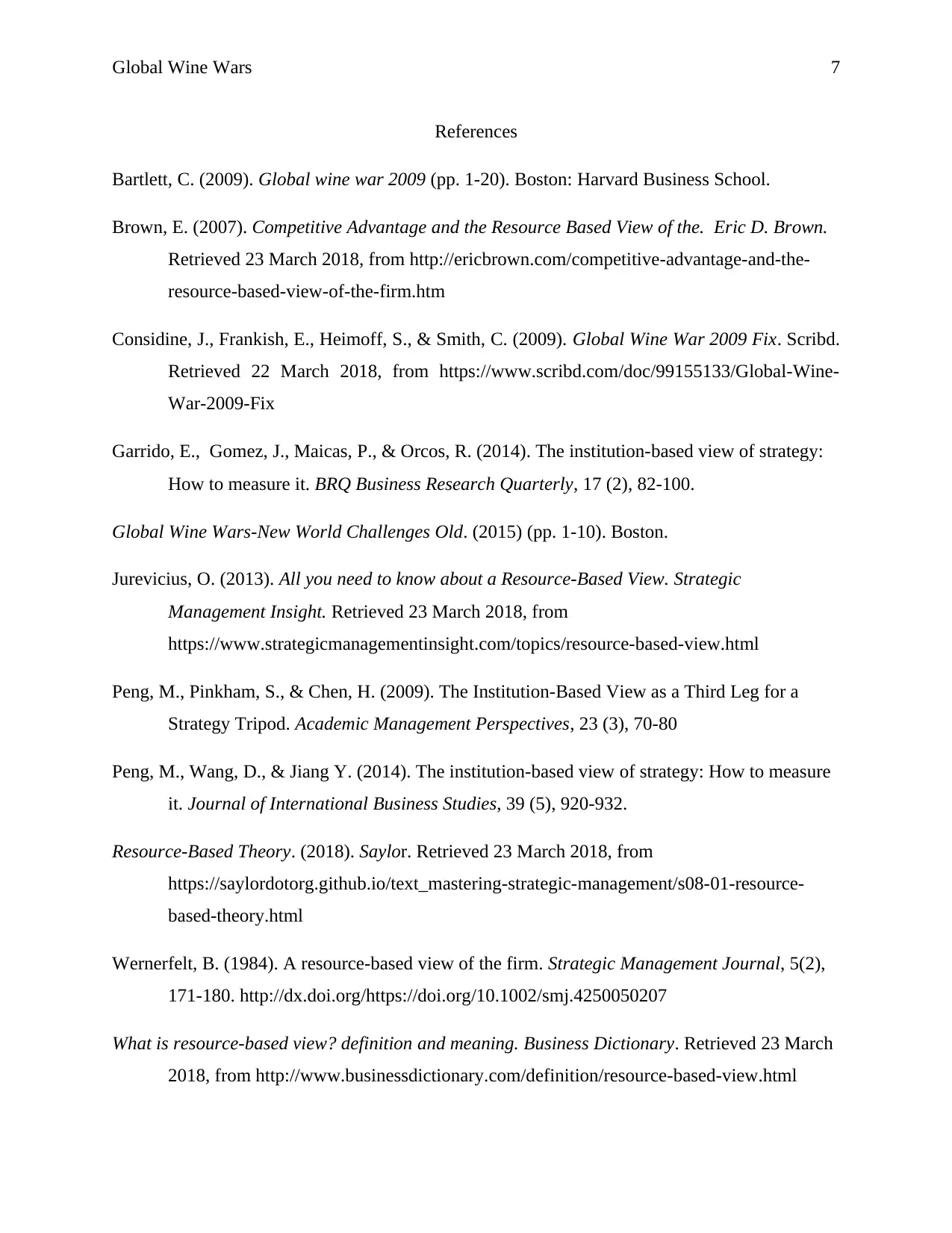
Global Wine Wars 7
References
Bartlett, C. (2009). Global wine war 2009 (pp. 1-20). Boston: Harvard Business School.
Brown, E. (2007). Competitive Advantage and the Resource Based View of the. Eric D. Brown.
Retrieved 23 March 2018, from http://ericbrown.com/competitive-advantage-and-the-
resource-based-view-of-the-firm.htm
Considine, J., Frankish, E., Heimoff, S., & Smith, C. (2009). Global Wine War 2009 Fix. Scribd.
Retrieved 22 March 2018, from https://www.scribd.com/doc/99155133/Global-Wine-
War-2009-Fix
Garrido, E., Gomez, J., Maicas, P., & Orcos, R. (2014). The institution-based view of strategy:
How to measure it. BRQ Business Research Quarterly, 17 (2), 82-100.
Global Wine Wars-New World Challenges Old. (2015) (pp. 1-10). Boston.
Jurevicius, O. (2013). All you need to know about a Resource-Based View. Strategic
Management Insight. Retrieved 23 March 2018, from
https://www.strategicmanagementinsight.com/topics/resource-based-view.html
Peng, M., Pinkham, S., & Chen, H. (2009). The Institution-Based View as a Third Leg for a
Strategy Tripod. Academic Management Perspectives, 23 (3), 70-80
Peng, M., Wang, D., & Jiang Y. (2014). The institution-based view of strategy: How to measure
it. Journal of International Business Studies, 39 (5), 920-932.
Resource-Based Theory. (2018). Saylor. Retrieved 23 March 2018, from
https://saylordotorg.github.io/text_mastering-strategic-management/s08-01-resource-
based-theory.html
Wernerfelt, B. (1984). A resource‐based view of the firm. Strategic Management Journal, 5(2),
171-180. http://dx.doi.org/https://doi.org/10.1002/smj.4250050207
What is resource-based view? definition and meaning. Business Dictionary. Retrieved 23 March
2018, from http://www.businessdictionary.com/definition/resource-based-view.html
References
Bartlett, C. (2009). Global wine war 2009 (pp. 1-20). Boston: Harvard Business School.
Brown, E. (2007). Competitive Advantage and the Resource Based View of the. Eric D. Brown.
Retrieved 23 March 2018, from http://ericbrown.com/competitive-advantage-and-the-
resource-based-view-of-the-firm.htm
Considine, J., Frankish, E., Heimoff, S., & Smith, C. (2009). Global Wine War 2009 Fix. Scribd.
Retrieved 22 March 2018, from https://www.scribd.com/doc/99155133/Global-Wine-
War-2009-Fix
Garrido, E., Gomez, J., Maicas, P., & Orcos, R. (2014). The institution-based view of strategy:
How to measure it. BRQ Business Research Quarterly, 17 (2), 82-100.
Global Wine Wars-New World Challenges Old. (2015) (pp. 1-10). Boston.
Jurevicius, O. (2013). All you need to know about a Resource-Based View. Strategic
Management Insight. Retrieved 23 March 2018, from
https://www.strategicmanagementinsight.com/topics/resource-based-view.html
Peng, M., Pinkham, S., & Chen, H. (2009). The Institution-Based View as a Third Leg for a
Strategy Tripod. Academic Management Perspectives, 23 (3), 70-80
Peng, M., Wang, D., & Jiang Y. (2014). The institution-based view of strategy: How to measure
it. Journal of International Business Studies, 39 (5), 920-932.
Resource-Based Theory. (2018). Saylor. Retrieved 23 March 2018, from
https://saylordotorg.github.io/text_mastering-strategic-management/s08-01-resource-
based-theory.html
Wernerfelt, B. (1984). A resource‐based view of the firm. Strategic Management Journal, 5(2),
171-180. http://dx.doi.org/https://doi.org/10.1002/smj.4250050207
What is resource-based view? definition and meaning. Business Dictionary. Retrieved 23 March
2018, from http://www.businessdictionary.com/definition/resource-based-view.html
1 out of 7
Related Documents
Your All-in-One AI-Powered Toolkit for Academic Success.
+13062052269
info@desklib.com
Available 24*7 on WhatsApp / Email
![[object Object]](/_next/static/media/star-bottom.7253800d.svg)
Unlock your academic potential
© 2024 | Zucol Services PVT LTD | All rights reserved.





